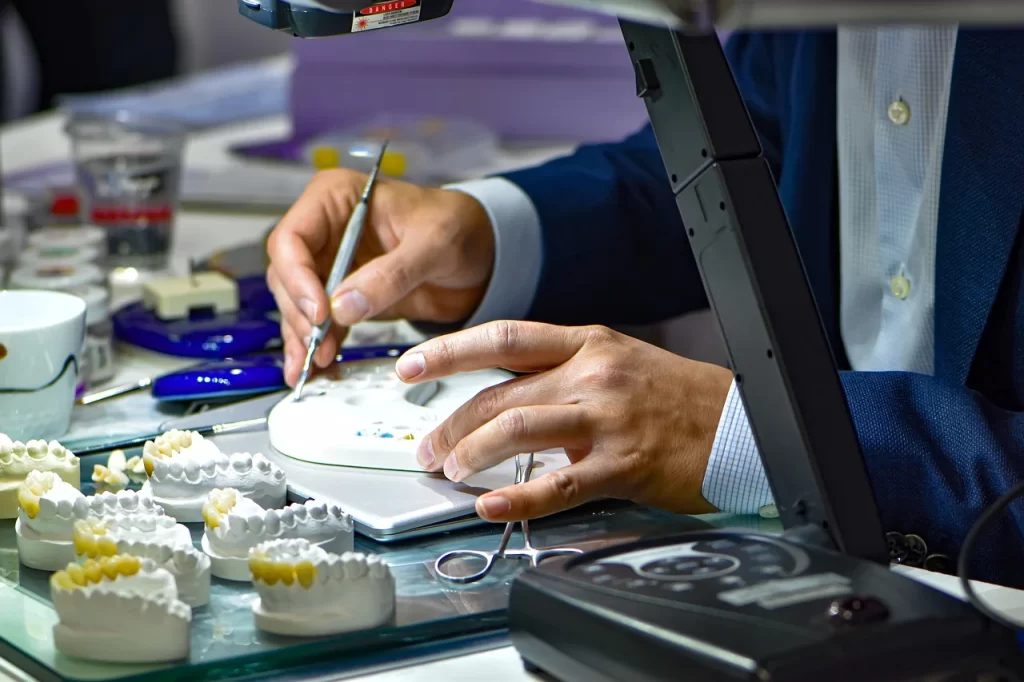The dental crown serves as a covering when other repair methods might prove ineffective. The dental crown sits on the prepared tooth or a dental implant, and the dentist may use this method for any number of problems. For example, what if there was extensive damage to your teeth due to severe decay? A crown can strengthen your tooth in place of other less permanent options, but it can also cover any unsightly cavities or discoloration. One of the considerable benefits is that you don’t have to worry about putting your teeth through more drilling or scraping. Anyway, only your dentist can decide whether you need a dental crown or not after examining your mouth’s condition. It’s worth noting that in some cases, a dentist may need to obtain a Drug Enforcement Administration (DEA number) to prescribe certain medications that may be necessary during the procedure.
If they recommend this treatment, you can expect the following things to happen after taking a call on the choice of material for the crown. However, let us briefly peek into the procedure of dental crown installation for the time being.
Preparation Work And Installation Of Dental Crown
A dentist can perform a root canal treatment to prepare the affected area for the crown. Once they clean bacteria and fix other issues, they will take an impression of the neighboring teeth and abutment to create mold and install a temporary crown until the suitable option is ready. When your treated area has healed and the new crown is ready, they can proceed with the installation. They will ensure that the dental crown sits appropriately, just like your natural teeth, while performing at its best. Remember, this is only a tiny overview of the procedure. The experience can vary based on your dental condition and the methods required to treat them.
Nevertheless, you will most likely come across two predominant material options for dental crowns – porcelain and zirconia. While porcelain is a traditional choice, the latter is more recent and advanced. You would want to know why one can be better than the other for this dental procedure. So, here is a quick view of this.
Porcelain Vs. Zirconia Dental Crowns
Porcelain-fused-to-metal (PFM) crowns
PFM crowns have porcelain on the top and metal at the bottom according to this expert dentist in Upper East Side. However, this can lead to a noticeable ring at the tooth’s base, making it pretty evident to the eyes. The ring does not look good when you compare it to natural teeth if your gums are receding. Also, porcelain tends to chip or detach itself from its base over time and provides a dull grey color inconsistent with the rest of your teeth.
For years, PFM crowns were the gold standard for dental restorations. It became increasingly popular because of itsdurability and ability to withstand high tension placed on its structure due to chewing. However, this type of material has its drawbacks, as hinted above. Over a certain threshold, the porcelain may fracture and separate from the metal substructure underneath, causing larger pieces to break off and require removal. When removal of those broken pieces becomes difficult, installing an entirely new crown can be the only option to give you back your beautiful smile.
Zirconia crowns
A zirconia crown is the best way to keep your smile looking its finest. Zirconia offers incredible strength and solid beauty for a fraction of the cost of gold or amalgam. And compared to porcelain, zirconia is much more durable. Your zirconium crown can’t wear down or become damaged over time.
The Decision Between Zirconia And Porcelain
When deciding between a Porcelain-Fused-to-Metal (PFM) crown and a Zirconia dental crown, there are many considerations. Crowns made of PFM tend to be more metallic so that they can affect the appearance of your teeth, with the remaining tooth tissue appearing whitish and unnatural. However, PFM crowns also tend to feature increased strength and durability. Conversely, zirconia dental crowns feature high stain resistance and whiter color, allowing for a natural aesthetic appearance. Additionally, zirconia is always preferable for patients who have metal allergies — sometimes, even a patient’s tissue will start to reject an alloy-based PFM crown in their mouth. Using material that might be harmful to one’s body is not ideal, so if you have an allergy to such substances, using a zirconia dental crown over PFM can be preferable.
Understanding Zirconia And Its Benefits
Zirconia, also called zirconium dioxide, is a strong ceramic used in crowns or fillings. Zirconia is one of the best ceramics available in the dental industry because it’s tough and durable. A brand new zirconia crown should take no longer than one or two sessionsfor a procedure to complete. The process involves taking an image of your existing teeth. Based on the mold, the dentist creates a core while the matter is still soft before putting it in the furnace to give it desired strength and hardness. After this, the core gets a coating of porcelain-like finish to make it look similar to your natural tooth. The dentist can install the crown in its required place as soon as it is ready while ensuring proper adjustment.
You can learn about the advantages of Zirconia dental crowns near Syosset, NY, by visiting the local dental office. In the past, zirconia may have failed to give natural-looking teeth, but it looks increasingly natural as it continues to evolve and improve over time. As such, zirconia is an excellent alternative to other dental porcelains. Like porcelain veneers or dental crowns, zirconia aims to provide patients with an affordable option concerning repairing and restoring their teeth. One benefit of using this material is that it prevents future damage beyond just getting the problem fixed because of its durability and longevity.
Care And Maintenance For Zirconia Dental Crowns
Dentists generally recommend brushing your zirconium crowns with a toothbrush and fluoride toothpaste to fight bad breath and cavities. You will also want to floss regularly. These critical elements should feature in your routine at least once a day, if not twice.
Most dental problems are preventable if you pay attention to hygiene and cleanliness. Your lifestyle choices like diet can also have a huge say in this. At the same time, a half-yearly or yearly visit to a dental clinic is a must.








